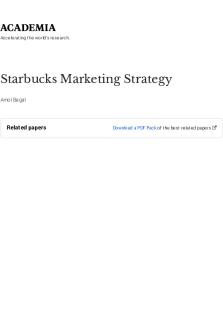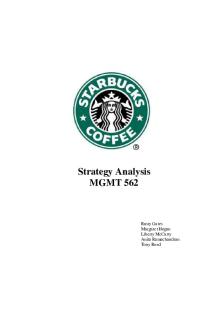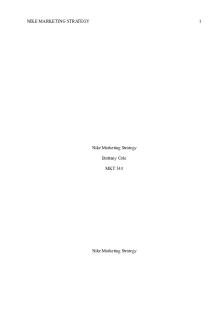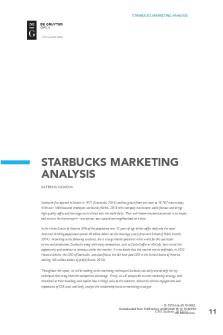Starbucks Marketing Strategy PDF

| Title | Starbucks Marketing Strategy |
|---|---|
| Author | Amol Bagal |
| Pages | 18 |
| File Size | 1.2 MB |
| File Type | |
| Total Downloads | 60 |
| Total Views | 449 |
Summary
INSTITUTE OF HOTEL MANAGEMENT AURANGABAD Marketing Management Amol Bagal Roll No: 1477497 “A project report on: Influence of consumers on marketing practices in context of Indian hospitality industry” “Submitted in Fulfilment of the Requirement for BA (Hons.) In Hotel Management” THE UNIVERSITY OF H...
Description
Accelerat ing t he world's research.
Starbucks Marketing Strategy Amol Bagal
Related papers
Download a PDF Pack of t he best relat ed papers
INSTITUTE OF HOTEL MANAGEMENT AURANGABAD
Marketing Management Amol Bagal Roll No: 1477497 A project report o : I flue ce of co su ers o arketi g practices i co te t of I dia hospitalit i dustr Submitted in Fulfilment of the Requirement for BA (Hons.) In Hotel Management
THE UNIVERSITY OF HUDDERSFIELD, UNITED KINGDOM
TABLE OF CONTENT CHAPTERS:
PAGE NO:
Introduction…………………………………………………………………….……........03 Case Study on Tata Starbuck in Indian Market…………….…………………….……....05 Discussion & analysis on marketing approach by Starbucks……………………................11 Conclusion ……………………………………………………………………………….15 References…………...…………………………………………………………….….......16
AMOL BAGAL 1477497
Page No. 2
INTRODUCTION Marketing in layman terms is communicating the company’s product to the potential customer and generate curiosity and demand for the same using various approaches. One of the recent approach that is being considered as the most important is the Consumer oriented marketing approach (Gulid & Lertwannawit, 2013). Over here we shall be covering consumer behavior theory and also customer oriented marketing strategy in brief.
Consumer Behavior Theory – The earlier approach to the consumer behavior was through the utility approach. This simply states that consumer decides to buy a product after mentally evaluation the estimated output generated by the product. But the modern day method focuses on various factors influencing consumers buying behavior. Major factors considered are:
Recognizing the need and want
Evaluating the substitutes available
Building purchase intentions
Searching for the information available about the product or service
Comparing the two
Post purchase satisfaction
Thus consumer behavior theory deals with understand a consumer’s willingness to buy and product till they buy and product and experience the satisfaction from it. What goes behind these factors are the consumers emotional, psychological, social needs, etc. that Maslow talks about in his theory (Conyette, 2012). This gives us a holistic approach without missing out on important factors.
AMOL BAGAL 1477497
Page No. 3
Customer Oriented Marketing Strategy – This approach revolutionized the marketing business. Before this strategy, company used to make a product and then find various appealing ways to advertise the same to the audience. But this approach works the other way round. We first find and understand the demands of the consumer and then make the products available to them. This approach is also know as ‘market-pull’ approach. This leads to increase in profits rather than simply increase in sales. The company’s goals should be go gain customer satisfaction at a fair price. Lets take a look at few elements that are considered during marketing:
Optimization of consumer lifetime values: If our strategy focuses on customer need, i.e. customer centricity, then this concept will help develop and maximize customer values
and gain competitive advantage in the market. Higher Customer Equity: This is the total of customer lifetime value. Thus consumer oriented approach will lead to retained and repetitive customers thereby increasing
customer equity. Strong Customer Relation: This is achieved by providing flawless services to the consumer prior purchasing and post selling of the products. This intern will increase customer equity (Gulid & Lertwannawit, 2013). CRM is another important aspect which allows higher consumer satisfaction. Few examples of company’s that follow CRM are –
JetHub is a private jet company that offers charter jet service on demand for the luxury or the super-rich. This is a great way cater to the higher class demands of these people who want to spend endless amounts on showcasing their money. Hence to manage this they use a CRM system by Zoho to keep exact and accurate tracts of the clientele.
Pillow Company is a company run by Deborah Main. She designs handcrafted luxury pillows for her clients. Again the company follows CRM system by Zoho.
AMOL BAGAL 1477497
Page No. 4
CASE STUDY ON TATA STARBUCK IN INDIAN MARKET Introduction Starbucks, a Seattle based café service superior quality coffee and unique Starbucks experience came into an alliance with Tata Global Beverage in 2011 to launch its product in Indian market for the first time. It is a 50:50 joint venture by both the companies. With an initial investment of $2 million, on 9th of October 2012, they opened their very first store in Elphinstone Building which was owned by Tata and was vacant for several years. Opening up a café in Indian market was extremely challenging for Starbucks. Indian Market had not allowed Starbucks to open in 2007 due to some legal obligations. Since then, Starbuck was looking for a strong trustworthy partner and hence came Tata group. After carefully studying the markets in other Asian countries like Japan and China, India was given a though as a potential market. It was found out that India is a potential long term market for their product and thus they launched in India. Under the leadership of Ms. Avani Davda, CEO Tata Starbucks and Howard Schultz, CEO Starbucks, by the year 2013, Starbucks had opened up 40 stores in just 17months (Iancu et al., 2014). Though it was a slow progress for them as compared to their strategy in USA, they were still progressing good. There was a net profit of $2.5 billion dollars with an increase of 23% in the financial year of 2013 (Starbuck, 2015). They had covered all the metropolitan A grade city’s in the country. Mumbai, Bangalore, Chennai, Hyderabad, Delhi, etc. each had Starbucks running at a good success rate.
AMOL BAGAL 1477497
Page No. 5
Challenges faced by Starbucks before and after entering the Indian market – India is a land of many cultures and diversity. This makes it difficult for any company to cater and establish itself in this market. When we talk about an MNC, it becomes all the more difficult to start and continue in profits in this ever changing complex market. I shall discuss some of the challenges faced by the Starbuck in India:
At first it was very difficult to even enter the Indian market due to its strict and rigid rules and regulations. Though after the liberalization in 1991, many companies entered the Indian market, it was never easy to enter. Starbucks had tried entering India’s market in 2007 but to disputes with the government on licensing, it was difficult for them to enter
and thus they abolished the plan. It was difficult for them to understand how the Indian market works and what the people would demand. Though being a part of Asia, it was very different from China and Japanese
market. Those countries were far more developed in all sense. High rental and investment cost made it difficult to sustain in the market for a long time (Iancu et al., 2014). It was absolutely important to reach break-even point so as to expand
the business and sustain over long term.
it towards the coffee culture by focusing on millennials and young generation.
Starbucks had to take the responsibility of changing the tea drinking culture or rather shift
Other competitors had priced their products at a very cheap rates. Thus Starbucks had to make a choice as to price its product based on competitors pricing or to follow the cost
regain approach to maintain its standards.
market. One wrong move could destroy the product reputation in the market.
Marketing strategies had to be specially taken care of because India is a very sensitive
Starbucks also had to maintain the same taste of coffee in India that it offers in other countries. Thus standardization was needed. And it would cost a lot of money to export beans from external countries, thus they had to find a way out.
AMOL BAGAL 1477497
Page No. 6
Marketing Strategies followed by Starbucks in context of Indian Market – As we spoke earlier about how companies changed their strategies from product-oriented or profitoriented to purely consumer-oriented strategies. However, Starbucks had always followed a consumer oriented business approach (Iancu et al., 2014). In the coming context, we shall understand how Starbucks successfully applied the marketing theories and strategies to win in the competitive market. According to the man who built the whole of Starbucks empire, Howard Schultz, it is a third place for a person to spend time after home and work. People perceived this as their third home which affected in a positive manner (Das, Eisner & Koru, 2015). They always focused on quality of their product and unique service experience. Let’s look at some of these strategies for Indian Market :
The most important strategy that Starbucks followed was to gain trust of Indians by coming into an alliance with the truly Indian based company which is Tata Global Beverages. By doing this, it clearly specifies that Starbuck identified their Stakeholders Map and wanted to capture their trust. By doing this they almost simplified dealing with the external stakeholders such as suppliers, distributers, creditors, etc. because the renowned name
TATA helped in dealing and making negotiations with the government as well. Starbucks started sourcing its coffee from Tata plantation sin Coorg district of Karnataka. Also they used equipment’s manufactures by Tata which led to lower costs. This helped in product development and standardization of the same coffee quality as it is in their other
outlets. This also helped in reducing the economic liabilities. Starbucks added new items into their menu to cater to the Indian palettes. On their website they proudly say that they have added custom menu items with unique Indian flavors. Some these dishes are Murg Kathi wrap, Chatpata Paratha wrap, Tandoori Paneer Sandwich, etc. (Starbuck, 2015) This lead to product development exclusively for Indian market.
AMOL BAGAL 1477497
Page No. 7
The high premium pricing policy started by Starbucks and not focusing on competitive pricing allowed it to cater to only elite upper-middle class people and in a age demographics of 24 – 40 who had higher spending capacity than the younger youth. This helped in Market Penetration to the people who actually cared about the superior and premium quality product and services (Talpau & Boscor, 2011). This also allows people to differentiate themselves under the elite super premium class covering the Esteem Needs
under Maslows Hierarchy of Needs.
it caught hold of new customers while this helped in retaining the current customers.
Eventually by providing free Wi-Fi, Visa cards and customized DVD’s for its customers,
Intensive training of floor level staff as well as the higher level by using various techniques such as blind tasting and inculcating thorough company values into the staff before commencing work. This helps in maintain the unique Starbucks experience as well as the
standardization of quality product. Starbucks has suspended using a few ingredients that do not pass the standards set by FSSAI. This shows that Starbucks in committed in complying with rules and regulations
of every country and that it fulfills and adheres to Legal Factor of Pestel. The Store designs are being designed in such a way that it maintains the culture and traditions of the place and marketed in such a way that it gives a homely touch to the Indian consumers. For example, the Koregaon park outlet in Pune holds reputation for its number and uniqueness of copper items use to highlight the rich copper culture of Pune (Starbuck, 2015). Another example is of Starbucks in Elphinstone Building, the decorative artifacts, floor designs, the furniture are all designed and made using locally sourced material by India craftsmen.
AMOL BAGAL 1477497
Page No. 8
Also Starbucks made its stores larger in size with more seating capacity to specially cater to Indian market after the Chinese and Japanese market. This allowed consumer to be more
comfortable and spend long times with friends or family in a premium lounge. Starbucks avoid franchising its outlets as an expansion strategy because it believes that franchising might reduce the unique and personalized service experience that they offer to
their customers over coffee. As a matter of Diversification strategy, Tata Starbucks will be launching Teavana in their existing stores from early 2017. This shall be a drastic change in the product offering because it shall cater to the majority of the Indians. Eventually it shall come up as a brand
in itself exclusively for Tea related products manufacture in the country itself. Starbucks is also coming up with mobile ordering system which shall allow people to order, pay and avail the discounts and offers of their Starbucks card through their mobile. This shall be a hit with the millennials of this market.
AMOL BAGAL 1477497
Page No. 9
Talking about The Marketing Environment of Starbuck in Indian context, The company is Tata Starbuck. The Figure below shows a pictorial form of the marketing environment. The immediate affecting area would be the micro-environment:
Customers are the Millenials and higher working class people with higher spending capacity.
Competitors are CCD, Barista Lavazza, McCafe, etc.
Supplier of coffee bean is done by Tata coffee estates from Coorg district of Karnataka. The external factors affecting the marketing in macro-environment: Ecological factor is adhered to by the company. They are aiming at saving 15% water in company owned stores since 2012. They are aiming at achieving 50% of energy by renewable sources. They are also using recycled flooring tiles, efficient lightings and eco-friendly paints.
The technology comes into action when we talk about using social media as a part of huge marketing technique to cater to younger generations who are techno-savvy. This is also a step towards a paperless society.
Social and Cultural factors are taken into consideration when Starbucks understand the deep religious and culture values in Indian Market and that how strong the Indian heritage is. Thus Starbucks launched a few items to specifically cater to Indian tastes.
Political and legal factors are taken care off. Being into a venture with Tata, it gives them an advantage while dealing with legal documents and policies. Also Starbucks is strictly adhering to Indian food regulation under FSSAI. Tata Starbuck Pvt. Ltd.
MicroEnvironm Macroent Environm ent
AMOL BAGAL 1477497
Page No. 10
DISCUSSION
&
ANALYSIS
ON
MARKETING
APPROACH
BY
STARBUCKS Let’s talk about these strategies that we discussed above in detail and relate as to why these were adopted in Indian context. Starbucks wanted to established itself in the Indian market keep in long term development and return on investment in mind. India has a diverse population, multiple cultures, age old traditions with a price sensitive market (Das, Eisner & Koru, 2015). This makes it’s a complex and complicated to understand what the consumers are demanding and hence one strategy cannot be used to cater to whole of the clientele. Let’s us discuss about various strategies and marketing approaches implemented by Starbucks in India:
Getting into a 50:50 joint venture with Tata Global Beverages, it established a very strong bond and trust with the India’s local population. Being in alliance with one of the most reputed Indian company that has an history of 114 years. This easily helped them a lot in negotiating and dealing with acquisitions of land for opening up stores. Though when we consider as to how much actually did it impact, there were only a few occasions when the prices offered were reduced after referring the name Tata. Hence because of this reason, the biggest store of India is in one of the Tata owned building in Mumbai. This also helped
while they were dealing with identifying and managing their external stakeholders. Again as being in venture with Tata, they did not have any problems in sourcing their coffee bean because Tata already had a its own coffee plantations and thus by setting up its standards according to the standards of Starbucks, it became a permanent supplier. This helped in reducing the cost and having a standardized supply. Also it put a positive impact in the consumer’s mind that all product used are of premium quality which are grown and processed locally in their very own country. This also gave an advantage for them to because they use all the equipment made by Tata which again gives them a standardized machinery and easy of repairing and post purchase maintenance.
AMOL BAGAL 1477497
Page No. 11
Starbuck is majorly focusing on only and only elite customers of Indian market. Now this gave them a brand name of being a superior product in the market. India has a prime number of people from 25-52years who are a part of higher spending group. Thus by focusing on these, it is able to gain higher revenue and eventually reached to break even. India had got 18% of its demographics who belong to age groups between 18-24years who are more frequent with the trend of spending time in cafes, but this group unlike in China and Japan has a very low spending capacity. The pie chart below gives a clear idea about Indian demographics and their spending capacity.
SPENDING CAPACITY ACCORDING TO DEMOGRAPHICS 0- 14years
15 - 24years
25 - 52years
7%
40%
53 - 64years
65 and above
6% 29%
18%
Unlike CCD Starbucks decide on a having a different strategy for its Indian market. Starbucks had followed a rapid expansion strategy and flooded the US market with stores in almost every city. But this was impossible to do in India due to high legalization process, strong competitive market and high land rents. Thus they are focusing on only prime metropolitan cities and till date it only operates in 6 cities and they have slowed down their expansion at least until they hit the break-even point as off now.
AMOL BAGAL 1477497
Page No. 12
Another important aspect that Starbucks changed in Indian context was that they understood they difference in the way people in India like consume their beverage as compared to other markets. So in US majority of the people take coffee on the go while in India, majority prefer sitting in the stores and having the coffee. The figure below shows us the percentage of people who prefer to sit, spend time and consume coffee over the people in other countries. This shows us the understanding of Starbuck about the needs and demands of its consumers. It was noted that peak hours for Indian to visit cafes was from 2pm to 6pm. Due to this reason, Starbuck focused on the interiors of...
Similar Free PDFs

Starbucks Marketing Strategy
- 18 Pages

STARBUCKS TRABAJO STRATEGY
- 14 Pages

Marketing Strategy
- 5 Pages

marketing strategy
- 5 Pages

Marketing Strategies - Starbucks
- 11 Pages

Starbucks Marketing Plan
- 28 Pages

Starbucks Strategic Marketing Plan
- 33 Pages

Hyundai\'s Marketing Strategy
- 3 Pages

LG\'s marketing strategy
- 3 Pages

PMK-Apple\'s marketing strategy
- 26 Pages

Digital marketing strategy Essay
- 7 Pages
Popular Institutions
- Tinajero National High School - Annex
- Politeknik Caltex Riau
- Yokohama City University
- SGT University
- University of Al-Qadisiyah
- Divine Word College of Vigan
- Techniek College Rotterdam
- Universidade de Santiago
- Universiti Teknologi MARA Cawangan Johor Kampus Pasir Gudang
- Poltekkes Kemenkes Yogyakarta
- Baguio City National High School
- Colegio san marcos
- preparatoria uno
- Centro de Bachillerato Tecnológico Industrial y de Servicios No. 107
- Dalian Maritime University
- Quang Trung Secondary School
- Colegio Tecnológico en Informática
- Corporación Regional de Educación Superior
- Grupo CEDVA
- Dar Al Uloom University
- Centro de Estudios Preuniversitarios de la Universidad Nacional de Ingeniería
- 上智大学
- Aakash International School, Nuna Majara
- San Felipe Neri Catholic School
- Kang Chiao International School - New Taipei City
- Misamis Occidental National High School
- Institución Educativa Escuela Normal Juan Ladrilleros
- Kolehiyo ng Pantukan
- Batanes State College
- Instituto Continental
- Sekolah Menengah Kejuruan Kesehatan Kaltara (Tarakan)
- Colegio de La Inmaculada Concepcion - Cebu




